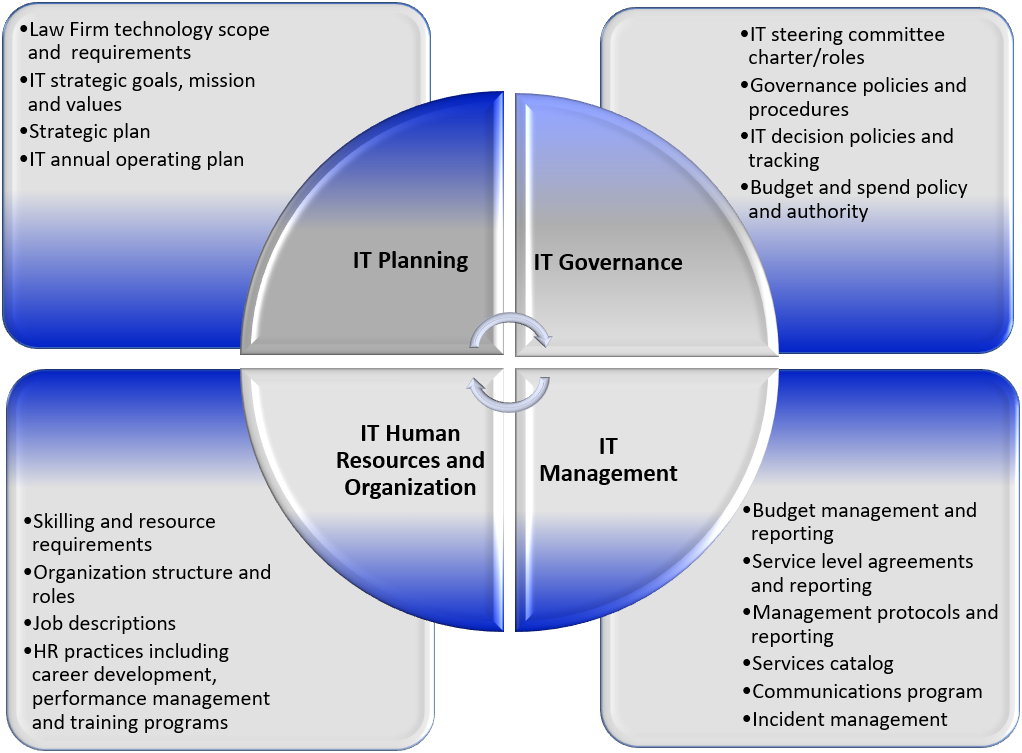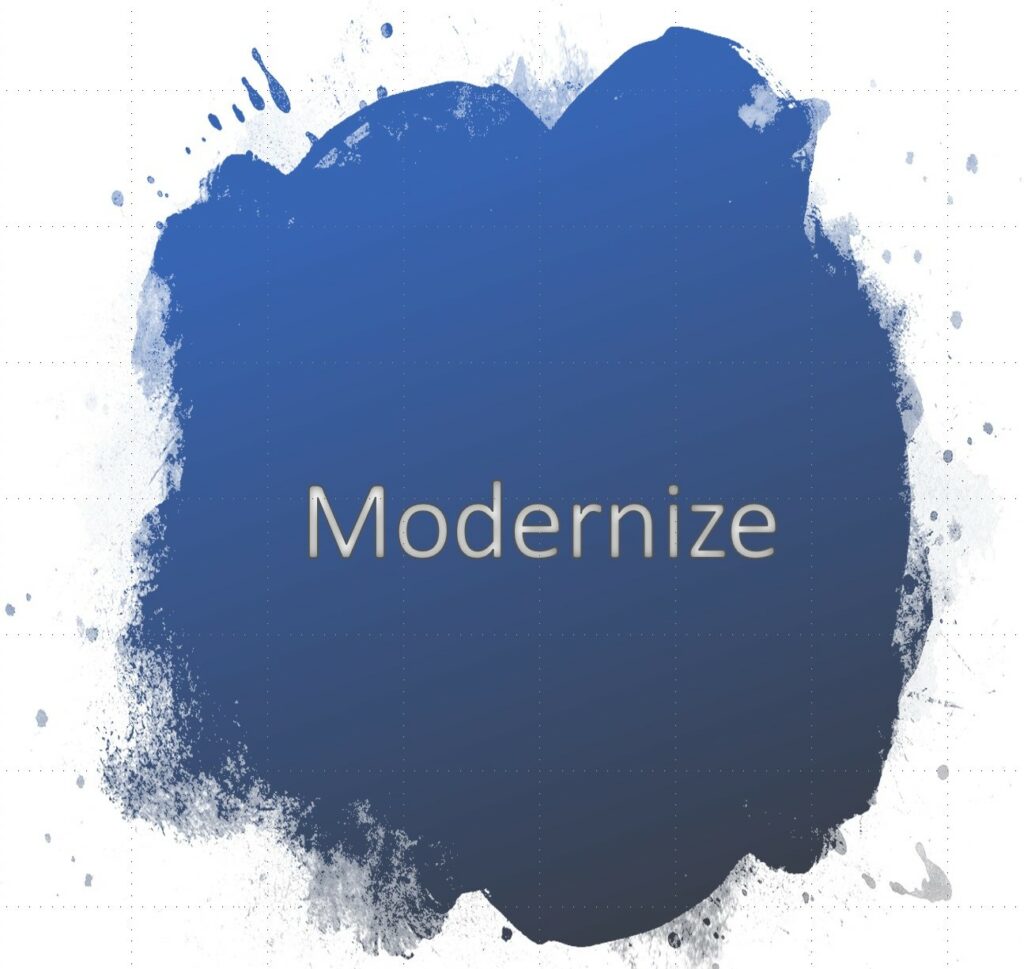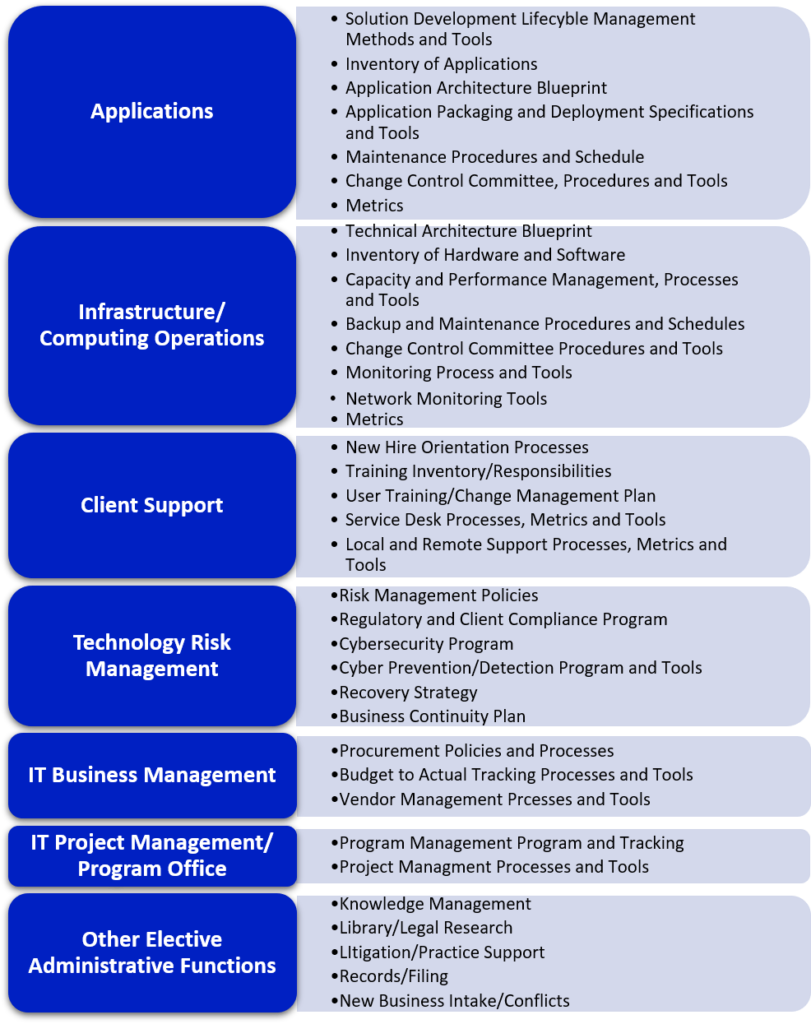Developing and maintaining a high performance Information Technology (IT) function within a law firm is not easy, especially these days. As the reader knows, we are experiencing unprecedented, highly disruptive changes in the present day legal market. The following is intended to provide a model for your own journey.
Before reading forward, please recognize a fundamental assertion. “Operational excellence is as much a journey, as it is a destination.”
To start, we should start with a definition of the sample scope of a law firm technology services organization. This may not fit every law firm technology organization, but it should serve as a reasonable start.
“An internal law firm technology services organization is responsible for the leadership, strategy, research, approach, planning, implementation, maintenance, user education, change management, user adoption and support of and for all technology related and enabled systems within the law firm and extended to clients and Stakeholders”.
The reader should note that many larger law firms have separated some elements of “technology related functions”. Examples of this are firms that have adopted separate functional Knowledge Management, Innovation, Client Technology, Litigation Support or other non-centralized technology delivery organizations. We know that technology is becoming increasingly intertwined in the support of both the “practice of law” and “business of law.“ Some firms choose to separate functions based on what they perceive are firm priorities.
IT MANAGEMENT and OPERATIONS MODEL INTRODUCTION
When looking at what it takes to develop and maintain a high performance IT function within a law firm, as just defined, we propose using the following Unbiased Consulting model that bifurcates the IT function into IT management and IT operational practices of the information technology function. Both are required as a means to manage the law firm IT function. Neither stands on its own; together they encompass the strategies, practices, processes and tools that we required to field high performing IT functions:

While Unbiased Consulting has developed its own law firm tailored practice set as a best practice model, another very viable option is for a law firm to use the Information Technology Infrastructure Library (ITIL) framework as a model. This standard is used more pervasively in the general corporate world, but we believe it to be a bit overzealous and complicated for most law firms. That being said, we work with the ITIL standard and also with law firms that use ITIL as their base practices model.
MODELS and CURRENT STATE
Unbiased Consulting IT Management Practices Model for Law Firms
The first half of the IT Practices Model for Law Firms is the IT Management Practices model. This represent the practices, processes and tools required to manage the IT function. The chart below depicts the base management functions that should exist within every law firm IT function:
- IT planning – strategic and tactical planning
- IT planning – strategic and tactical planning
- IT planning – strategic and tactical planning
- IT planning – strategic and tactical planning
Each quadrant of the Unbiased Consulting IT Management Practices Model depicts management practices and focus areas required from the IT management team. Below, we capture the practices and the linkages to processes and tools. For the sake of brevity, we will not detail each of these in this article, rather we provide it for your reference.

Please note that this Model has withstood the test of time and legal market change. God IT management practices remain just that – good management practices.
IT Operations Practices Model for Law Firms
We will now discuss the second half of the model, the Unbiased Consulting IT Operations Practices Model. This model is used to depict the basic operations functions that should exist within every law firm IT function.
Unlike the IT Management Practices Model, We observe substantive changes in the definitions and practices pertaining to the IT Operations Practices Model. We will first outline the major operations practices below and then will provide our perspectives on the changes we see in each operational practices area.
The definitions of base IT operations practice can vary somewhat by law firm, but on whole, the practices include:
- Applications – IT practices that span requirements identification, selection, design, testing, implementation, management, maintenance and expert support of the software applications leveraged by the firm’s lawyers and administrative team, and often, end clients as well.
- Infrastructure/ Computing Operations – IT practices that encompass requirements identification, selection, design, testing, implementation/installation, management, maintenance and expert support of the desktop environment, the networks/storage, access control, and overall hardware and software infrastructure leveraged by the firm’s lawyers and administrative team. This operations practice is increasingly focusing on vendor management, in support of Cloud and outsourced based services.
- Client Support – IT practices that span what is frequently referred to as the IT Service Desk (a.k.a. Help Desk), Desktop Support and User Technology Training.
- Technology Risk Management – practices relating to compliance, cyber-security, business continuity/disaster recovery and overall business risk management.

- IT Business Management – IT practices that represent the shared business services within the IT function, including but not limited to procurement, fulfillment, financial reporting and vendor management
- IT Project/Program Management Office – IT practices that include the project and program management solution delivery life cycle. In this case, it also includes “business analysis” practices required to align the law firm user community needs with IT.
Other Elective Administrative Functions. Depending on the scope defined by the Firm, the IT function may also own and manage the following Administrative practices, though we will not dive deeply in this article.
- Knowledge Management
- Library/Legal Research
- Litigation/eDiscovery/Practice Support
- Records/Information Governance Management
- New Business Intake/Conflicts
IT Management Practices Change
On whole, the management of the IT function remains and will likely remain largely unchanged, with the exception of increased needs to effectively manage vritual and outsourced resources. While many law firms have used outsourced and remote employees and managed same over the years, the scale of remote management has expanded exponentially as a result of the 2020 Pandemic. IT managers, as of this writing, are mainly managing by email, phone and video services, however they have and are adopting collaboration technologies including Microsoft Teams, Slack, Trello, Zoom and Smartsheet. Remote task management remains in its infancy, and IT managers need further mentoring, training and abilities to better track remote resources. Strong and open communications mechanisms are being adopted. Opportunities exist to support task management, managing and monitoring resource utilization. Employee retention of remote resources will continue to be of great concern.
IT Operations Practices Change
Based on the practices are defined, some discussion is required to address the changing landscape.
- Applications – We see the increased adoption of cloud and SaaS software applications and the flexibility provided, will continue to reduce desktop and packaging practice requirements. Cloud based applications will cause the desktop environment to become less customized, which will reduce the focus on some applications testing and packaging practices.

Based on this sea-change, applications practices are morphing to include a strong focus on vendor management practices. We are already seeing that applications understanding and analysis of requirements will continue to be a strategic practice set for law firm IT functions.
Additionally, in law firms where a separate Knowledge Management function exists, a subset of the firm’s software applications and associated responsibilities normally found in the applications and program/project management areas within the IT function, may now exist within that function.
- Infrastructure/ Computing Operations – Typically this area includes practices relating to data center management, IT backup/recovery and overall systems monitoring. In some firms, database management may live within the Applications practices and deskside support practices may reside under the Client Support practices. In general, we believe that desktop support practices are more appropriately owned by Client Support.
As briefly discussed earlier, cloud adoption is driving major changes and evolution of today’s operations practice sets. As these solutions become more pervasive, the legal market will reduce internal reliance and investment on traditional infrastructure practices. We believe that migration work will occur over the next 3-7 years, but see a mid-term, continuing internal focus on high level system engineering and true systems integration practices being owned within the IT function. As noted above, vendor management practices are quickly evolving as importance grows.
- Client Support – We observe that the past decade of outsourcing Service Desk (a.k.a. Help Desk), desktop support and client support practices have yielded mixed results. In working with many law firm clients that outsource the service desk and elements of desktop support, we find that a minority are truly happy with outsourced support, so they, in certain cases, look to take this back inside. Some firms use outsourcers for just after-hours support, and still others, use 3rd party support providers for weekday support. Prior to the Pandemic, we observers a trend for some members of the outsourced team to be physically resident on a client’s site as a hybrid inside/outside outsource model, though the financial model makes this option less attractive. Another trend is for the firm to request the service desk outsource to provide full time, dedicated resources, assigned to the firm.
Training practices are evolving. Most often, technology training practices are owned by IT, but in some firms the practices are shared between IT and Human Resources. In general, most firms do not incent lawyers to attend training, so quite a few different models have evolved, with most firms adopting a combination of deskside, classroom, “genius bar” or virtual or recorded, self-service training. On whole, we great need for increased and sustained (“institutionalized”), training, leveraging a variety of training disciplines and offerings.

- Technology Risk Management – Law firms have experienced a disruptive focus on risk management practices over the past eight years. Compliance, cyber-security, disaster recovery/business continuity and overall business risk management and tracking practices have been thrust upon the IT function, and firms have been forced to grapple with developing strong practices – in many places where none existed formerly. More and more firms are recognizing the strong linkage of these practices to the firm’s overall risk management function. We continue to see firms build a matrix structure where the operational practices are jointly owned by both the IT function as well into the risk management/OGC. We frequently recommend a total migration of the function, such that it reports directly to the firm’s risk management/loss prevention function, breaking the IT centric reporting to support more of a business focus and avoid IT conflicts of interest .
- IT Business Management – While often overlooked as its own set of practices, these represent the shared business services within the IT function. While these operations practices were typically owned by the IT function leader, more and more IT leaders are recognizing that structured operations practice (policy, process and tools are required).
- IT Project Management/ Program Office – The value of program and project management practices were long ago recognized by corporate America. They recognized the value of having good program/project practices to ensure project success and to manage resources, costs and timelines. While larger law firms have adopted differing models, few have recognized their full potential. More recently, as law firms continue to experience strong pressure from both clients and internal shareholders, we see a renewed focus on these operations practices. Law firms are beginning to experiment with similar practices (i.e., Legal Project Management) to support the delivery of substantive legal engagements which we believe will further spur the internal leverage of strong practice sets.
Interestingly, we have seen instances where the IT function’s program/project management practices (and organization) have been co-opted by law firm administrative management as there is increasing understanding that these practices have applicability outside of IT.
Lastly, firms that do not have a formally defined Knowledge Management function have recognized the value of having “business analysts” and “business analysis” sub-functions, to ensure that the law firm’s legal and administrative practices (e.g., practice group chairs, line lawyers, administrative areas) are aligned with the IT function and vice versa. These IT operational practices enable a “go to” and someone who understands their business, internal and client needs. These analysts bring solutions to the practices and ensure that the IT function is responsive and aligned to business needs. Firms with Knowledge Management functions typically subsume the business analyst practices into that function.
CONCLUSION
In summary, when looking at what it takes to develop and maintain a high performance IT function within a law firm, we believe you must focus on building and maturing both IT management and IT operational practices. We hope that the definitions, the models, current state and our view of changes required, to support the maturity of IT functions in most law firms.

A plan, timeline, resourcing and rigorous and focused execution are the keys to success.
Whether you assess your IT function’s maturity internally, or you hire an outside expert to help with your technology assessment, you will be well served to develop and document a baseline. The baseline will allow you to measure progress in maturity as well as client satisfaction.
Two final thoughts. One, you can’t do it all at once. We are fond of the saying, “One can only boil the ocean one bucket at a time…”. Second, the reminder, remember it is a journey.
APPENDIX – Unbiased Consulting
IT Operations Practices – Processes and Tools Inventory for Law Firms

For those law firm readers that desire more detail relating to the Unbiased Consulting Operations Practices model discussed earlier in this article, we have opted to share linkages key processes and tools to be considered by the firm. In certain ways, IT and operations management might view the following as a “checklist” for analyzing the IT department’s best practice and tools maturity. As stated at the beginning of this article, ITIL and other methodologies can offer delivery models and toolset lists. The following has been developed as a practical, achievable, law firm focused target set, to ensure progress on your law firm IT journey:

